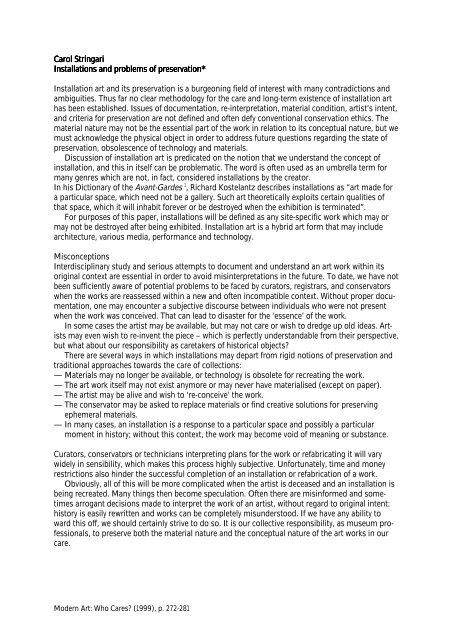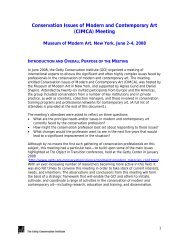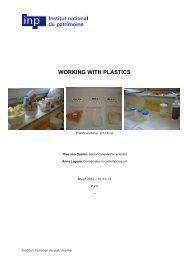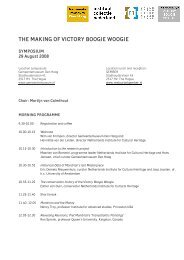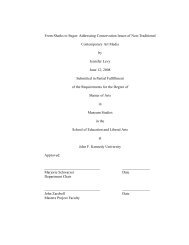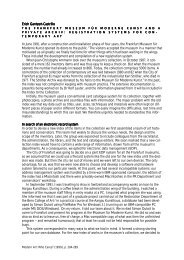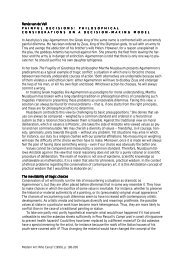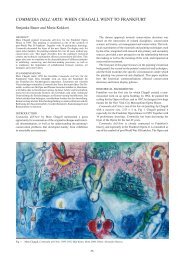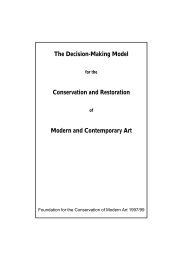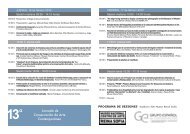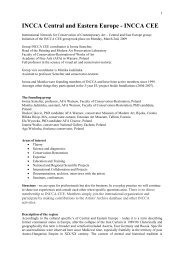Installations and problems of preservation.pdf - incca
Installations and problems of preservation.pdf - incca
Installations and problems of preservation.pdf - incca
Create successful ePaper yourself
Turn your PDF publications into a flip-book with our unique Google optimized e-Paper software.
Carol Stringari<br />
Installa<br />
lations <strong>and</strong> <strong>problems</strong> <strong>of</strong> preser<br />
erva<br />
vation*<br />
Installation art <strong>and</strong> its <strong>preservation</strong> is a burgeoning field <strong>of</strong> interest with many contradictions <strong>and</strong><br />
ambiguities. Thus far no clear methodology for the care <strong>and</strong> long-term existence <strong>of</strong> installation art<br />
has been established. Issues <strong>of</strong> documentation, re-interpretation, material condition, artist’s intent,<br />
<strong>and</strong> criteria for <strong>preservation</strong> are not defined <strong>and</strong> <strong>of</strong>ten defy conventional conservation ethics. The<br />
material nature may not be the essential part <strong>of</strong> the work in relation to its conceptual nature, but we<br />
must acknowledge the physical object in order to address future questions regarding the state <strong>of</strong><br />
<strong>preservation</strong>, obsolescence <strong>of</strong> technology <strong>and</strong> materials.<br />
Discussion <strong>of</strong> installation art is predicated on the notion that we underst<strong>and</strong> the concept <strong>of</strong><br />
installation, <strong>and</strong> this in itself can be problematic. The word is <strong>of</strong>ten used as an umbrella term for<br />
many genres which are not, in fact, considered installations by the creator.<br />
In his Dictionary <strong>of</strong> the Avant-Gardes 1 , Richard Kostelantz describes installations as “art made for<br />
a particular space, which need not be a gallery. Such art theoretically exploits certain qualities <strong>of</strong><br />
that space, which it will inhabit forever or be destroyed when the exhibition is terminated”.<br />
For purposes <strong>of</strong> this paper, installations will be defined as any site-specific work which may or<br />
may not be destroyed after being exhibited. Installation art is a hybrid art form that may include<br />
architecture, various media, performance <strong>and</strong> technology.<br />
Misconceptions<br />
Interdisciplinary study <strong>and</strong> serious attempts to document <strong>and</strong> underst<strong>and</strong> an art work within its<br />
original context are essential in order to avoid misinterpretations in the future. To date, we have not<br />
been sufficiently aware <strong>of</strong> potential <strong>problems</strong> to be faced by curators, registrars, <strong>and</strong> conservators<br />
when the works are reassessed within a new <strong>and</strong> <strong>of</strong>ten incompatible context. Without proper documentation,<br />
one may encounter a subjective discourse between individuals who were not present<br />
when the work was conceived. That can lead to disaster for the ‘essence’ <strong>of</strong> the work.<br />
In some cases the artist may be available, but may not care or wish to dredge up old ideas. Artists<br />
may even wish to re-invent the piece – which is perfectly underst<strong>and</strong>able from their perspective,<br />
but what about our responsibility as caretakers <strong>of</strong> historical objects?<br />
There are several ways in which installations may depart from rigid notions <strong>of</strong> <strong>preservation</strong> <strong>and</strong><br />
traditional approaches towards the care <strong>of</strong> collections:<br />
— Materials may no longer be available, or technology is obsolete for recreating the work.<br />
— The art work itself may not exist anymore or may never have materialised (except on paper).<br />
— The artist may be alive <strong>and</strong> wish to ‘re-conceive’ the work.<br />
— The conservator may be asked to replace materials or find creative solutions for preserving<br />
ephemeral materials.<br />
— In many cases, an installation is a response to a particular space <strong>and</strong> possibly a particular<br />
moment in history; without this context, the work may become void <strong>of</strong> meaning or substance.<br />
Curators, conservators or technicians interpreting plans for the work or refabricating it will vary<br />
widely in sensibility, which makes this process highly subjective. Unfortunately, time <strong>and</strong> money<br />
restrictions also hinder the successful completion <strong>of</strong> an installation or refabrication <strong>of</strong> a work.<br />
Obviously, all <strong>of</strong> this will be more complicated when the artist is deceased <strong>and</strong> an installation is<br />
being recreated. Many things then become speculation. Often there are misinformed <strong>and</strong> sometimes<br />
arrogant decisions made to interpret the work <strong>of</strong> an artist, without regard to original intent:<br />
history is easily rewritten <strong>and</strong> works can be completely misunderstood. If we have any ability to<br />
ward this <strong>of</strong>f, we should certainly strive to do so. It is our collective responsibility, as museum pr<strong>of</strong>essionals,<br />
to preserve both the material nature <strong>and</strong> the conceptual nature <strong>of</strong> the art works in our<br />
care.<br />
Modern Art: Who Cares? (1999), p. 272-281
Questions <strong>of</strong> tempo<br />
poral<br />
rality<br />
Many installation works are not actually conceived in their entirety in advance but rely quite heavily<br />
on circumstances during the process. Artists <strong>of</strong>ten work directly <strong>and</strong> spontaneously on a work at<br />
the time <strong>of</strong> installation, allowing it to develop in response to a particular space or letting it evolve<br />
during its creation. Some artists are better than others at preconception. This can sometimes result<br />
in a work being unresolved or less than ‘perfect’ for an exhibition. If the work is purchased out <strong>of</strong> an<br />
exhibition, it is then frozen in this state – defined as an historical moment. The ambiguity <strong>of</strong> the<br />
artist may be reflected when the institution who purchased the piece attempts to contact the artist<br />
during a reinstallation <strong>and</strong> the artist wishes to conceive the work differently. This is not necessarily<br />
a problem, but if one <strong>of</strong> the museum’s goals is to preserve the integrity <strong>of</strong> the work it owns the<br />
question arises: can such works be mutable, or will each new conception be a new acquisition?<br />
What exactly, then, is being purchased when a museum acquires an installation? 2, 3<br />
The conservators’ role at the time <strong>of</strong> acquistion is to apply their knowledge <strong>of</strong> materials in order<br />
to fully document the installation. They should be able to anticipate certain materials issues <strong>and</strong><br />
technological requirements having an impact on the life span <strong>of</strong> the work.<br />
Many <strong>problems</strong> regarding the care <strong>of</strong> these art works are not yet resolved or may even be irresolvable.<br />
But hopefully raising the issues will assist other museums in underst<strong>and</strong>ing <strong>and</strong> interpreting<br />
their own works <strong>of</strong> a similar nature. The need for communicating experience <strong>and</strong> information is<br />
obvious, since many <strong>of</strong> us are confronted with exactly the same <strong>problems</strong> <strong>and</strong> are responding to<br />
them quite differently. If some form <strong>of</strong> network or exchange could be set up to record experiences<br />
with different artists’ work, it may save much unnecessary reinvention <strong>of</strong> the wheel. It would be useful<br />
to have an accessible record <strong>of</strong> curators <strong>and</strong> conservators who have had particular experiences<br />
with specific artists – as <strong>of</strong>ten occurs during the staging <strong>of</strong> an exhibition, when they may well be<br />
exposed to an overall sense <strong>of</strong> how an artist thinks <strong>and</strong> works. This might also save the artists from<br />
fielding phone calls by conservators who tend to ask the same questions repeatedly. A way to retain<br />
the information might be to include a short essay in exhibition catalogues on the artist’s intent <strong>and</strong><br />
the long-term <strong>preservation</strong> <strong>of</strong> the work (if applicable).<br />
Food for thought: some examples<br />
One <strong>of</strong> the earliest examples <strong>of</strong> installation art I traced was an intervention in the exhibition ‘First<br />
Papers <strong>of</strong> Surrealism’ in New York, held at the Whitelaw Reid mansion at 451 Madison Avenue in<br />
1942. André Breton was the organiser <strong>of</strong> this exhibition, for the benefit <strong>of</strong> the Coordinating Council<br />
<strong>of</strong> French Relief Societies. Breton asked Marcel Duchamp to come up with a provocative installation.<br />
Duchamp purchased 16 miles <strong>of</strong> string <strong>and</strong> proceeded to create a huge spider’s web throughout<br />
the exhibition space. This intervention, which made it very difficult to view some <strong>of</strong> the works,<br />
is cited as a metaphor for the prevalent opinion that the work <strong>of</strong> Surrealists was obscure <strong>and</strong> difficult<br />
to read.<br />
In addition to the string installation, Duchamp also created a ‘happening’ way before its time.<br />
He employed a group <strong>of</strong> youngsters dressed in athletic gear to play around <strong>and</strong> within the web.<br />
They were told to respond to any objections that “Mr Duchamp told us we could play here”. 4 This<br />
was a truly radical event at the time, <strong>and</strong> Duchamp did not even show up for it.<br />
I do not believe such an ‘installation’ was ever meant to be preserved. There is photographic documentation<br />
<strong>and</strong> it is recorded in historical texts. It may be that one day some curator decides to<br />
recreate it, but then it will not be a work <strong>of</strong> art – only an historical depiction. As far as I know the<br />
string no longer exists. Today, in our anxious attempt to preserve materials <strong>and</strong> record every event<br />
or creation, we would probably save something like this.<br />
It is a famous example, but undoubtedly there are numerous works <strong>of</strong> this kind throughout the<br />
twentieth century which could be categorised as installations <strong>and</strong> are now lost completely. Attempting<br />
to preserve every such work may be beyond the requisite responsibility <strong>of</strong> historians or conservators,<br />
falling into the fetish collection category. It can be very difficult, however, to distinguish<br />
between <strong>preservation</strong> <strong>and</strong> fetishisation when the inherent nature <strong>of</strong> institutions is to memorialise<br />
Modern Art: Who Cares? (1999), p. 272-281
<strong>and</strong> sanctify – not to mention that conservators may feel quite threatened by the notion <strong>of</strong> an art<br />
work having no material substance.<br />
Not all cases are so extreme, however, <strong>and</strong> the nuances <strong>of</strong> the discussion can be quite interesting.<br />
In memory <strong>of</strong> the earthquake victims <strong>of</strong> Mezzogiorno <strong>and</strong> in solidarity with the left-wing politicial<br />
party Lotta Continua, Joseph Beuys conceived Terremoto during a political discussion in 1981 when<br />
he was in Rome (Palazzo Braschi). The installation includes a linotype press which had been<br />
thrown away by Lotta Continua; manifestos from this political party were placed on the machine,<br />
advertising the Third Way – which opposed the <strong>of</strong>ficial, existing social systems <strong>of</strong> Marxism <strong>and</strong> its<br />
opposite, capitalism. The Italian flag was wrapped in felt, wax was poured onto the keyboard, <strong>and</strong><br />
there is a rubbish can with fat <strong>and</strong> lead.<br />
There are also numerous blackboards arranged in the manner <strong>of</strong> a house <strong>of</strong> cards. On one <strong>of</strong><br />
these, diagrams <strong>of</strong> Jupiter <strong>and</strong> Saturn constellations are shown. The others reflect Beuys’ theory <strong>of</strong><br />
human expression, depicting human sorrow <strong>and</strong> a range <strong>of</strong> emotional facial contortions .<br />
In this sculptural context, Beuys treats the themes <strong>of</strong> human emotion, mechanical processes, political<br />
opposition, alchemical procedures <strong>and</strong> planetary references. The importance <strong>of</strong> the work is the<br />
experience <strong>of</strong> its entirety <strong>and</strong> not so much each element in particular. It is this overall effect which<br />
generates a specific reaction from the viewer.<br />
Relationships between elements are precarious, reflected in their unstable positioning. This tenuous<br />
arrangement is extreme in the case <strong>of</strong> the blackboards: they are placed at angles, supporting<br />
each other like a stack <strong>of</strong> cards. Beuys used blackboards during lectures <strong>and</strong> happenings, <strong>and</strong> they<br />
are <strong>of</strong>ten part <strong>of</strong> his works. Their meanings vary – some are relics <strong>of</strong> an action or lecture, others<br />
have been given a sculptural status.<br />
Although in some cases Beuys did use traditional blackboards, in this instance they are painted<br />
chipboard – not slate. They present a <strong>preservation</strong> challenge due to their fragile surfaces. They are<br />
meant to lean directly on the floor <strong>and</strong> against each other; the images are done in chalk <strong>and</strong> are<br />
very vulnerable. The character <strong>of</strong> the work does not support the possibility <strong>of</strong> fixing the chalk. Former<br />
attempts to fix these chalkboards (by an unknown h<strong>and</strong>) were unsuccessful <strong>and</strong> have left a<br />
mottled gloss on the surface. The public, being attracted to them, <strong>of</strong>ten attempts to add to the<br />
composition by smearing the chalk <strong>and</strong> writing comments in the dust which builds up on the surface.<br />
Removal <strong>of</strong> the dust presents a challenge because it is not possible to clean the boards<br />
thoroughly without disturbing the chalk or creating halos around the image.<br />
How much <strong>of</strong> the dust can <strong>and</strong> should be removed? To what extent would this dust be acceptable<br />
to the artist <strong>and</strong> when will it become unrepresentative? For the conservator as caretaker <strong>of</strong> a<br />
museum object, the approach to the <strong>preservation</strong> <strong>of</strong> this work is not obvious. Beuys stated: “That is<br />
why the nature <strong>of</strong> my sculpture is not fixed <strong>and</strong> finished: processes continue in most <strong>of</strong> them –<br />
chemical reactions, fermentations, colour changes, decay, drying up. Everything is in a state <strong>of</strong><br />
change.” 5<br />
Our concern for the long term <strong>preservation</strong> might be an absurdity to Beuys, the artist <strong>and</strong> creator<br />
<strong>of</strong> transformative works. According to several sources, Beuys’s widow feels that it is important<br />
to relax <strong>and</strong> have fun with the work: try to enter into the spirit <strong>of</strong> the pieces. 6 Therefore, a relaxed<br />
attitude has been adopted about the dust on these blackboards – to remove whatever possible<br />
without disturbing the chalk <strong>and</strong> to preserve the overall ‘feeling’.<br />
With time, however, the images may become invisible. Then this attitude will require a reevaluation.<br />
The work <strong>of</strong> Joseph Beuys needs study before <strong>preservation</strong> decisions are made; each<br />
work is quite complex <strong>and</strong> may operate under different criteria. The general conclusion with regard<br />
to this work is the necessity for underst<strong>and</strong>ing the intent <strong>of</strong> his works, <strong>and</strong> to find a balance where<br />
conservation st<strong>and</strong>ards are upheld without getting bogged down in minute details.<br />
James Turrell’s works <strong>of</strong>ten consist <strong>of</strong> nothing but a plan or the construction material to create a<br />
space, with specific lighting <strong>and</strong> technical requirements. In Sky Window he utilised the window <strong>and</strong><br />
Modern Art: Who Cares? (1999), p. 272-281
what the window framed as integral to the work. Turrell works with the space, creating an environment<br />
which speaks pr<strong>of</strong>oundly to the viewer or visitor. 7<br />
The problem here is not that <strong>of</strong> preserving an object. This installation, set up in the Panza Villa<br />
in Varese <strong>and</strong> now belonging to the Guggenheim Museum, is a site-specific work <strong>and</strong> will not<br />
inhabit any other space. Recently it was deinstalled in order to complete renovations to the villa.<br />
The documents were carefully review-ed in order to ensure that it will be reinstalled correctly. When<br />
the artist created the work, specific instructions were given as to how the existing space should be<br />
modified to enable the creation. A certificate <strong>of</strong> ownership <strong>and</strong> Document <strong>of</strong> Realisation are an<br />
essential component <strong>of</strong> the work.<br />
Although the environment/installation was primarily constructed with new walls, they were most<br />
certainly a response to the villa – for example, to the lunette window. Other essential components<br />
<strong>of</strong> the piece are the daylight, especially the direction <strong>of</strong> the light, <strong>and</strong> what can be viewed from the<br />
window. All <strong>of</strong> these components would be impossible to recreate in another building or l<strong>and</strong>scape.<br />
If the building were destroyed, the work would live on only as documentation.<br />
The artist is very clear in the documentation that certain technical parameters must be followed.<br />
He specifies with utmost precision such details as lighting, projectors, wall finish, the height <strong>of</strong> the<br />
floor under the entrance etcetera. He also states that he should be contacted <strong>and</strong> sign <strong>of</strong>f on any recreation<br />
<strong>of</strong> the space.<br />
As far as I know, the re-creation <strong>of</strong> his works after his death has not been addressed – so possibly<br />
the work will die with him. This points to the necessity <strong>of</strong> well structured interviews with the<br />
artist, to define the works in the museum’s collection <strong>and</strong> hopefully to document his general philosophy<br />
for the continuation <strong>of</strong> his oeuvre (Guggenheim Museum curators are planning to confront<br />
these issues with the artist, but at present they feel that no Turrell work should ever be recreated<br />
without his involvement). The outcome <strong>of</strong> the interviews should contribute to the overall<br />
comprehension <strong>of</strong> the artist’s work. Results <strong>of</strong> such an interview should be accessible to others<br />
who encounter similar works <strong>and</strong> are trying to interpret his work <strong>and</strong> future documentation. Some<br />
important questions for works by Turrell would be:<br />
— How much latitude (if any) is allowed for changes in materials, dimensions, technology?<br />
— Will someone be designated as executor who can sign <strong>of</strong>f on re-creations after his death?<br />
— Is there someone who the artist feels has a pr<strong>of</strong>ound <strong>and</strong> accurate underst<strong>and</strong>ing <strong>of</strong> his work?<br />
Città Irreale, Millenovecentoottantanove was conceived for a show at the Guggenheim Museum,<br />
New York, in 1989 – created in situ as an immediate, spontaneous response to the space. At the<br />
artist’s request a number <strong>of</strong> different materials were collected. The artist then worked with these<br />
elements to gradually create the igloos. He began to cut the glass sheets with gr<strong>and</strong> gestures but<br />
this method in fact turned out to be impractical, so the art h<strong>and</strong>lers measured them <strong>and</strong> carefully<br />
fitted the broken glass onto the clamps.<br />
The work begins with a very simple structure, the igloo, which Merz transforms during the creative<br />
process. It refers to energy, shelter, electrical poles <strong>and</strong> oppositions. Both its meaning <strong>and</strong><br />
physical structure are complex <strong>and</strong> layered. Opposing forces <strong>and</strong> materials combine to form a precarious<br />
architecture, with stable <strong>and</strong> unstable materials juxtaposed <strong>and</strong> supporting each other. 8<br />
An interesting issue pertaining to the work is the existence – or non-existence – <strong>of</strong> the neon element.<br />
Originally, this was a separate work. Two versions <strong>of</strong> the neon piece were in the exhibition,<br />
one owned by the Stedelijk Museum Amsterdam <strong>and</strong> one owned by a private lender. The neon work<br />
from the private lender was used on top <strong>of</strong> the large igloo at the last minute, being an unpredictable<br />
aspect <strong>of</strong> the creative process. It was an integral part <strong>of</strong> the installation – which was titled after<br />
this element – at the Guggenheim.<br />
The work was acquired by the Guggenheim at the time, but not documented clearly. There was<br />
no indication whether this neon element was supposed to be copied or borrowed from the lender<br />
every time the work was reinstalled. An attempt was made by the art h<strong>and</strong>ling/technical staff to recreate<br />
the element, but this was neither successful nor authorised: the artist has suggested that we<br />
show the piece without the neon element. Until further decisions are made, this is how the work<br />
will be installed.<br />
Modern Art: Who Cares? (1999), p. 272-281
These issues are not particularly important to the artist, who works in a style contrary to formulaic<br />
interpretations <strong>and</strong> rigid outlines. However, the fact that the museum acquired a work which is<br />
incomplete needs to be documented <strong>and</strong> defined. This raises questions about exactly what is being<br />
purchased when an installation is acquired, <strong>and</strong> what freedom does the owner have when reinstalling<br />
it? The materials for this piece have been retained, but it is also unclear to what extent they are<br />
replaceable <strong>and</strong> how close to the original replacements must be. For example, a roughly cut piece<br />
<strong>of</strong> glass may be easily substituted, but should shapes <strong>and</strong> sizes be specified? If the latex yellows<br />
<strong>and</strong> discolours, should it be replaced? And when will the materials no longer reflect the ‘meaning’<br />
<strong>of</strong> the work? Is it preferable to have the elements which were tied <strong>and</strong> cut by the artist’s h<strong>and</strong>, or<br />
doesn’t it matter?<br />
The installation Cry Dragon/Cry Wolf:The Ark <strong>of</strong> Genghis Khan by Cai Guo Quang, a contemporary<br />
Chinese artist working in New York, was created as a site-specific work in conjunction with the<br />
Guggenheim staff for the 1997 Hugo Boss exhibition. Hundreds <strong>of</strong> sheep skin bladders were used<br />
to make five rafts, with alanthus branches, string, <strong>and</strong> wooden oars. Three Toyota engines are suspended<br />
from the ceiling <strong>and</strong> kept running during the installation.<br />
The skins arrived deflated <strong>and</strong> mouldy – so they needed to be soaked, cleaned <strong>and</strong> inflated with<br />
a compressor. Also, many areas had to be patched. On the inside the skins were coated with sesame<br />
oil, however, which made it difficult to achieve a bond. Several adhesives were tested. The artist<br />
brought a very toxic rubber cement type material, with MEK as the solvent, from Japan. This<br />
appeared to be the only effective adhesive, although possibly not the most stable or most healthy<br />
choice. Epoxy was used to fill areas <strong>of</strong> gathers which were torn <strong>and</strong> broken.<br />
Alanthus branches, fairly easy to obtain, were collected from the park service. However, the artist<br />
was quite particular about the sticks <strong>and</strong> their groupings. The branches were brittle <strong>and</strong> split<br />
easily, <strong>and</strong> the process <strong>of</strong> tying them into bundles was time-consuming. The Toyota motors were<br />
adapted to make them run on electricity instead <strong>of</strong> the unsafe <strong>and</strong> expensive gasoline combustion<br />
<strong>of</strong> the originals. The motors require constant maintenance <strong>and</strong> a barrier or alarm must be used to<br />
protect the public from the exposed engines.<br />
The work also raises issues <strong>of</strong> <strong>preservation</strong>, materials <strong>and</strong> their degradation, <strong>and</strong> changes in scale<br />
to accommodate different spaces. We are becoming more aware <strong>of</strong> the need for proper documentation<br />
<strong>and</strong> since the museum’s technical staff carried out the work, a complete file was produced on<br />
its material nature <strong>and</strong> installation requirements. The artist was actively involved in the process.<br />
The extensive <strong>and</strong> complex documentation prepared by various museum departments contains the<br />
following:<br />
— A precise numbering system for all elements.<br />
— A diagram <strong>and</strong> blueprint <strong>of</strong> the installation with XY coordinates.<br />
— The height <strong>of</strong> each raft, the curves <strong>and</strong> the relationship <strong>of</strong> the piece to the gallery – which the artist<br />
expressed as important concerns.<br />
— Photographic documentation (many views) <strong>and</strong> video tapes.<br />
— A lighting report.<br />
— A maintenance record for the motors, including details on the purchase <strong>of</strong> extra parts <strong>and</strong> their<br />
storage in a proper environment.<br />
— Design <strong>of</strong> storage <strong>and</strong> cost analysis for maintenance, transport <strong>and</strong> long-term storage.<br />
— Notes on conservation, how to obtain replacement parts, the artist’s feelings about the longterm<br />
<strong>preservation</strong> <strong>of</strong> the work.<br />
Although the artist preferred that the piece was not dismantled, it was impractical <strong>and</strong> virtually<br />
impossible to move <strong>and</strong> store the work intact.<br />
Complete documentation was easy to gather because the artist is very meticulous <strong>and</strong> clear<br />
about the materials <strong>and</strong> how he sees the piece. However, the work has been considered for other<br />
spaces <strong>and</strong> the artist is willing to make significant alterations to accommodate smaller rooms.<br />
Modern Art: Who Cares? (1999), p. 272-281
A scheme for documen<br />
menta<br />
tation<br />
tion<br />
These few examples present different scenarios, each with its own set <strong>of</strong> criteria. They reflect a<br />
range <strong>of</strong> potential issues <strong>and</strong> raise important questions to ponder when confronted with similar<br />
works. One common thread linking all <strong>of</strong> these examples is that careful documentation is the key to<br />
the interpretation <strong>and</strong> decision-making process for the future. Time can blur the most crystal-clear<br />
idea. Quite common is the tendency to apply contemporary sensibilities to historical objects; as<br />
these works become more planted in the history <strong>of</strong> art, there will be a tendency towards revisionism<br />
<strong>and</strong> skewed perceptions.<br />
The issues <strong>and</strong> questions raised by these examples can also be applied to more contemporary<br />
works which include electronics or computer generated images. Al-though each object will have its<br />
own concerns, the philosophical basis for discussing the museum’s role as caretaker remains the<br />
same: how do we best serve the art? This may be by maintaining <strong>and</strong> storing the materials in their<br />
present state, or by transferring images or information to a more stable electronic form, or by deriving<br />
a plan for replacement <strong>of</strong> obsolete technology in conjunction with the artist. 9 In all cases, accurate<br />
information about the intent <strong>of</strong> the piece is a prerequisite. Working with colleagues in other<br />
disciplines – art historians, technicians, registrars, industrial scientists, fabricators – is necessary<br />
for a holistic underst<strong>and</strong>ing <strong>of</strong> the pieces <strong>and</strong> to foresee pitfalls.<br />
Thus, it is essential to set up a scheme for documentation <strong>and</strong> to produce a thorough document<br />
when the original piece is constructed. Every work will have its own requirements, so the outline<br />
cannot be too rigid. It should be kept in mind that the inherent nature <strong>of</strong> creativity defies our obsessive<br />
need to categorise <strong>and</strong> catalogue. Acknowledging this, the following outline can serve as a<br />
guide for those <strong>of</strong> us who have the responsibility for seeing these installation works into the future:<br />
1. Photo-documentation <strong>of</strong> all stages <strong>of</strong> the process <strong>and</strong>, if applicable, video <strong>and</strong> sound documentation.<br />
2. Complete notes <strong>and</strong> documentation for the initial development stage.<br />
This is <strong>of</strong>ten crucial in the underst<strong>and</strong>ing <strong>of</strong> why certain things were done. Many times compromises<br />
are made during installations due to cost factors, time restrictions <strong>and</strong> limited availability <strong>of</strong><br />
materials. Knowing the history behind certain decisions makes the reinstallation <strong>of</strong> a work much<br />
easier. Within any institution, it is quite difficult to establish a methodology for recording these<br />
decisions. They are <strong>of</strong>ten made during informal conversations or during last-minute installations<br />
<strong>and</strong> do not get passed along. The appointment <strong>of</strong> a documentation coordinator would facilitate this<br />
process – he/she keeping up with the work, asking questions about any decisions taken <strong>and</strong><br />
attempting to underst<strong>and</strong> what the concept is as it unfolds.<br />
3. Coordination between the curator, registrar, conservators, technicians <strong>and</strong> lighting specialists in<br />
order to underst<strong>and</strong> the ‘whole’ installation.<br />
In this way uninformed <strong>and</strong> inappropriate decisions can be avoided as much as possible.<br />
4. Solicitation <strong>of</strong> reports from all participants in the project.<br />
This would include technicians, curatorial representatives, curators, registrars, lighting consultants,<br />
electricians, etcetera. These reports would be collected <strong>and</strong> reviewed by the documentation coordinator,<br />
citing all inconsistencies.<br />
5. Central archive to file reports.<br />
Easy access in the event that the piece needs to be refabricated. This reduces the possibility that<br />
individual files will be lost <strong>and</strong> that personnel changes within the institution cause loss <strong>of</strong> valuable<br />
information.<br />
6. Interview with the artist.<br />
It is ideal if the artist can be persuaded to focus on the banal aspect <strong>of</strong> documentation at some<br />
time close to the installation <strong>of</strong> the original work. In that way artists are able to give an accurate<br />
Modern Art: Who Cares? (1999), p. 272-281
epresentation <strong>of</strong> the process <strong>and</strong> how they feel about the work. Information acquired in retrospect<br />
is <strong>of</strong>ten transformed quite dramatically <strong>and</strong> thus can be difficult to reconcile with the original documentation.<br />
The interviews should be done by one designated person who underst<strong>and</strong>s the piece<br />
<strong>and</strong> is able to establish a dialogue with the artist. The interviewer should keep it brief <strong>and</strong> precise,<br />
knowing what essential questions should be answered. It is counterproductive to ask the artist<br />
repeatedly the same questions or have many people within an institution bothering the artist with<br />
these details. Although we may feel it is very important, it is <strong>of</strong>ten not the artist’s main concern.<br />
7. Presentation <strong>of</strong> potential pitfalls for the future.<br />
Many artists are reluctant to discuss how they feel about the work being reinterpreted or reinstalled<br />
in the future. They <strong>of</strong>ten find that the piece is only relevant to the present situation; in such cases<br />
the documentation <strong>of</strong> the piece may be the only necessity. The work then becomes a moment in<br />
history, never to be constructed, only read about or viewed in photographs or films. But over time<br />
the attitude towards reconstructing the work may change <strong>and</strong> the artist may become more willing<br />
to have works reinstalled in different environments, with different criteria <strong>and</strong> on a different scale.<br />
The initial interviews can be helpful in obtaining information about the importance <strong>of</strong> elements<br />
such as specific materials <strong>and</strong> what to do if they are not available, <strong>and</strong> about the parameters for<br />
altering a colour, light, measurement, etcetera – depending on the situation at h<strong>and</strong>. Some artists<br />
are very casual about their ideas <strong>and</strong> enjoy having them transformed by history <strong>and</strong> circumstance;<br />
others are far more tied to their materials. In some cases, the relationships inherent in the piece<br />
must be preserved in order to preserve the intent. One must carefully study whether these things<br />
are crucial to the essence <strong>of</strong> the piece or not.<br />
8. Architectural plans <strong>and</strong> blueprints should be retained <strong>and</strong> preserved in as much detail as possible.<br />
9. Conservation treatments.<br />
Any treatment <strong>of</strong> the pieces should be carefully documented, as well as the thought process behind<br />
it. When working with living artists, they may supervise repairs or alterations. These decisions may<br />
not be in line with conservation st<strong>and</strong>ards, therefore it is helpful to have documentation as to why<br />
certain materials were chosen; the reason is <strong>of</strong>ten as simple as the artist being familiar with a certain<br />
product or having it on h<strong>and</strong> at a crucial moment.<br />
10. Reinstallations.<br />
When a work is reinstalled, there are inevitable grey areas where decisions are made which may not<br />
conform to the original specifications, or they may be an interpretation <strong>of</strong> an unclear document or<br />
blueprint. It is extremely helpful to have these decisions documented, since ‘mistakes’ or<br />
‘misinterpretations’ are <strong>of</strong>ten h<strong>and</strong>ed down <strong>and</strong> become more drastic alterations after several generations.<br />
Obviously this process <strong>of</strong> documentation takes many hours <strong>and</strong> personnel to organise, enter data,<br />
file data <strong>and</strong> update records. This is not always possible with-in the hectic pace <strong>of</strong> a busy institution<br />
that is understaffed <strong>and</strong> working on many projects simultaneously. However, this type <strong>of</strong> documentation<br />
ultimately saves time <strong>and</strong> money for the institution: the research <strong>and</strong> preparation for reinstallation<br />
does not have to be started anew every time if all documents are in place. Increased underst<strong>and</strong>ing<br />
<strong>of</strong> the historical responsibility by museum administrators will allow this to become more<br />
routine within institutions.<br />
Beware <strong>of</strong> the tendency to fetishise – the conservator is at a loss when there is no substance to lay<br />
h<strong>and</strong>s on. Although we have a responsibility to document <strong>and</strong> preserve the art works, it is important<br />
not to lose sight <strong>of</strong> a bigger picture where art exists in a continuum. If a work has been, or is,<br />
nebulous, possibly that is the nature <strong>of</strong> the piece. Documentation at all costs, whether that means<br />
harassing the artist <strong>and</strong> their studio or attempting to preserve the most ridiculous detail which has<br />
Modern Art: Who Cares? (1999), p. 272-281
no effect on the overall concept, can be detrimental to the process. It can also destroy good working<br />
relationships between the artist <strong>and</strong> the museum pr<strong>of</strong>essional.<br />
In attempting to create a scheme for underst<strong>and</strong>ing this genre <strong>of</strong> art, I sincerely hope that<br />
respect for the creative process <strong>and</strong> its spontaneity is not lost. The fact that art is not always<br />
created in a rational, orderly fashion is fortunate, <strong>and</strong> we should not lose perspective. The harmonious<br />
whole <strong>and</strong> not each singular element is what constitutes a successful work. When this Gestalt<br />
is lacking, it may be necessary to ‘retire’ the installation. Retirement... another field <strong>of</strong> study.<br />
1 Richard Kostelanz, Dictionary <strong>of</strong> the Avant-Garde, A Cappella Books <strong>and</strong> imprint <strong>of</strong> Chicago<br />
Review Press Inc., Chicago, 1993.<br />
2 Jon. Ippolito, ‘The Museum <strong>of</strong> the Future: A Contradiction in Terms?’, in: Artbyte (New York)<br />
volume 1,<br />
no. 2, June-July 1998, pp. 18-19.<br />
3 Susan Hapgood, ‘Remaking Art History’, in: Art in America, July 1990, pp. 115-119.<br />
4 Calvin Tompkins, Duchamp, Henry Holt <strong>and</strong> Company, New York, 1996, pp. 332-333.<br />
5 Caroline Tisdall, Joseph Beuys, Solomon R. Guggenheim Museum, New York, 1979.<br />
6 Conversation with conservator for the Beuys estate, Mr. Otto Hubacek, 1997.<br />
7 Craig Adcock, James Turrell: The Art <strong>of</strong> Light <strong>and</strong> Space, University <strong>of</strong> California Press, Los<br />
Angeles, 1990.<br />
8 Germano Celant, Mario Merz, Solomon R. Guggenheim Museum, New York, <strong>and</strong> Electra, Milan,<br />
1989.<br />
9 See note 2, where Ippolito proposes a Variable Media Initiative.<br />
Carol Stringari is conservator at the Solomon R. Guggenheim Museum<br />
* The article was originally published in: Hummelen, IJ., Sillé, D., Modern Art: Who Cares?,<br />
Amsterdam: Foundation for the Conservation <strong>of</strong> Modern Art/ Netherl<strong>and</strong>s Institute for Cultural<br />
Heritage, 1999, p. 272-281.<br />
Modern Art: Who Cares? (1999), p. 272-281


